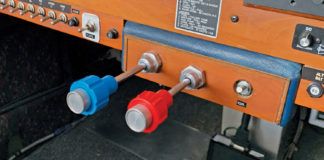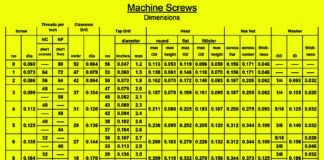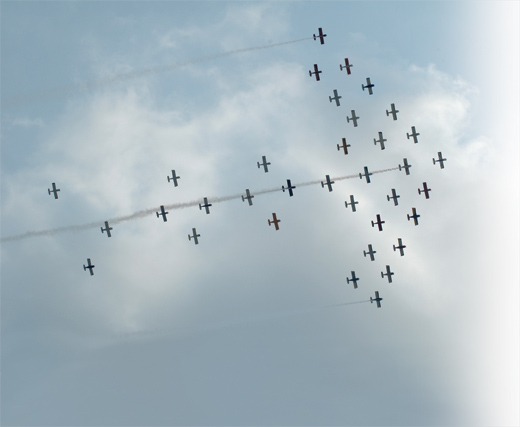
A group of four Van’s RVs are precisely lined up at the runup area at Chino Airport in Southern California. The flight lead, Gary “Condor” Sobek, is looking up the line of RVs waiting for the hand signal that the flight is ready to go. When the runups are complete and satisfactory, a “thumb’s up” is passed down from the last RV (number four) to three, to two, to one.
A radio call is made on a discrete frequency from flight lead: “Raven flight check?” and it is answered in sequence by the wingmen—two, three, four—signifying that the flight is ready to go. Flight lead then calls “Raven flight, push tower,” which means the flight is instructed to switch (push) the frequency from the discreet frequency to the CNO tower frequency. The flight lead again calls, “Raven flight check?” and the responses from the wingmen come in sequence: two, three, four.
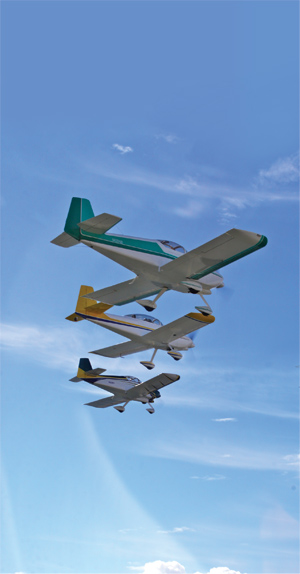
Flight lead then calls: “Chino tower, Raven flight of four RVs is ready to go 26 Right; request left turn out.” The tower responds: “Raven flight, cleared for takeoff; left turn out approved.” The four RVs taxi out and line up for a four-ship takeoff in a slightly acute—the wingman’s leading edge even with the trailing edge of lead or, in the case of number four wingman, even with the trailing edge of number three—strong right “fingertip” position, and look for the lead’s hand signals. Lead indicates with his raised hand and swirling index finger indicating that throttles be advanced to 1700 rpm; lead makes an exaggerated head nod, and the flight of four starts its takeoff run.
Once airborne, the individual wingmen close to their correct positions, and the flight begins its turn and climbs toward the practice area over Lake Matthews.
A Day in Our Lives
What you’ve just read about is nowhere near the beginning of our preparations for formation practice, but it is the most visible element to bystanders. It’s fair to ask why we do it, but the answer can’t be summed in a single word (though “fun” comes closest). We do it for a variety of reasons. Formation flying is complex and demanding; we train for it rigorously and with greater detail planning than most pilots ever commit. Like any demanding exercise, when it’s done well, formation flying is tremendously rewarding. Finally, it’s a social event—we as a group join to talk about flying, sure, but sharing such an activity tends to strengthen our bonds as friends.
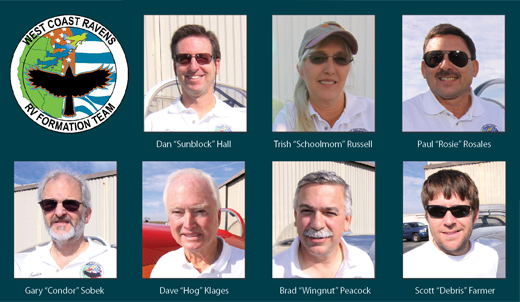
Basic Formations
During a formation flight, a series of hand signals or plane movements, such as rocking the wing, moving the rudder back and forth rapidly, or moving the elevator up and down rapidly, are used by the flight lead to communicate the various configurations of the formation. The mantra “A quiet flight is a good flight” is the rule, and radio communications are held to a minimum.
We’ve flown locally around Chino with as many as 16 planes during the “pre-show” at the Chino Planes of Fame Airshow; and at the annual Aviation Nation at Nellis Air Force Base in 2010, we had a total of 22 planes. The really large flights are an ensemble of RV formation groups from all over the country. All the members of the flight are “carded” FFI wingmen, flight leads, or check pilots. These flights are all lead by Stu “Falcon” McCurdy, and he does a wonderful job of leading the group.
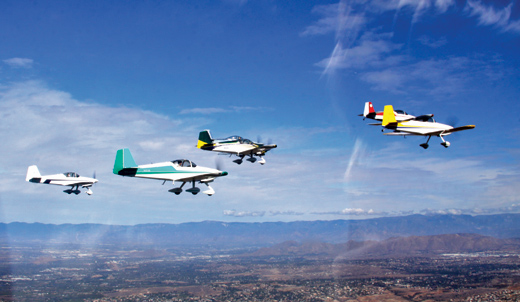
This is the Double V formation with six ships.
In previous years, we would practice for two days for the large formations to be flown at AirVenture. In 2007 we did a 35-ship formation in honor of Van’s Aircraft’s 35th anniversary, and followed that up with a 37-ship formation for Van’s 37th anniversary in 2009. A 40-ship flight is planned for 2012. The individual groups all practice regularly and when the large flights are formed, we practice the large formations. Obviously the really large formations only happen once every couple of years.
Today’s flight of four is in the basic Finger Four formation. If you look at your right hand with the fingers extended and palm down, this depicts the Finger Four Strong Right formation. Flight lead is represented by the middle finger, wingman number two is the index finger, number three is the third finger, and number four is the little finger. Lead and number two are an element, and numbers three and four are the second element. If you use your left hand, palm down, you have the diagram for Finger Four Strong Left. The Finger Four formation is the basic four-ship formation, and all other formation configurations start from the Finger Four formation.
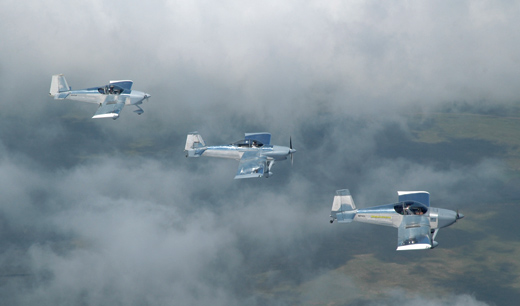
Three of the West Coast Ravens team head to Oshkosh 2007: JP, Wingnut and Sharpie.
The Echelon formation is formed by flight lead either by signaling while crossing under the number two wingman to the other side of the formation while numbers three and four move over to make room, or signaling for numbers three and four to cross under to the other side. Remember that flight lead (number one) and number two are an element, and numbers three and four are an element. This formation configuration has numbers two, three and four staggered back on the same side, either the left or right. It is from this formation configuration that the “pitchout” or break to land is initiated.
The Diamond formation configuration is formed from the Fingertip formation by a signal from the flight lead to number four. Often this signal is passed on by number three. Number four slides back and moves over to the slot between number two and number three, and then moves up into the Diamond formation.
The signal for Trail formation is the rapid movement up and down of the elevator by the flight lead. At this signal, number four drops back, number three drops back, and number two drops back and moves into trail position, where number two is located approximately three-fourths of a ship length behind the flight lead and down several feet, lower than the slipstream of the flight lead. Number three moves into a similar position behind number two, and number four moves in behind number three, making a radio call “four’s in” so that the flight lead knows that the trail formation has been formed.
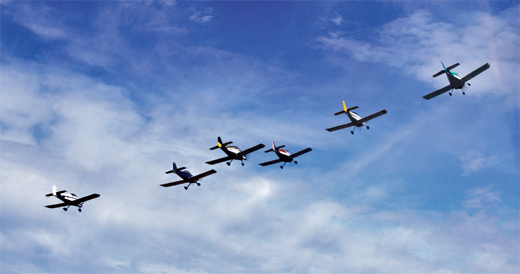
This is the Delta formation with six ships.
The Wingman
The basic position for a wingman in a flight of RVs is to establish a site picture by reference points off of his or her lead. The basic position is determined by sighting and superimposing the outboard aileron hinge of the lead’s closest wing to the spinner of lead. The wingman is always stepped down several feet below the lead. The other reference point is sighting the outboard side of the lead’s elevator where a couple of inches of the outboard elevator trailing edge can be seen by the wingman. If these reference points are maintained, the wingman is in position.
It takes a demonstration by an experienced formation pilot with the new formation pilot (newbie) as a passenger to fly in position correctly and safely, and lots of practice to maintain these skills. After the demonstration, the newbie will then fly his or her airplane with the experienced formation pilot riding along as a safety pilot.
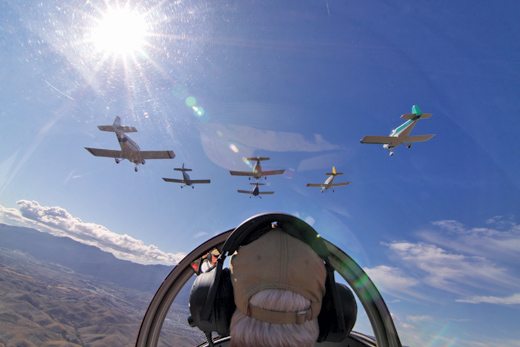
This is an interesting view of the Double V formation. The RV-8 used as the camera platform here is not part of the Double V, but was positioned to get the shot.
The flight of four RVs does the various formation configurations and then maneuvers in these positions through various turns, climbs and dives such as lazy eights. The flight is configured in an Echelon and then the lead signals for a break or pitchout and a rejoin. The RVs are in an extended trail position following the break, where the RVs are approximately 500 to 800 feet in trail. The rejoin is accomplished when the flight lead signals by wagging his wings and then turning in the direction of the rejoin, either right or left. The rejoin is accomplished by the wingmen individually turning their planes in a slightly tighter arc (radius) than the lead, establishing a reference picture by visually placing their planes in a position where the lead’s vertical fin is superimposed over the outboard wing, and individually flying the arc up for the rejoin. This is one of the most challenging maneuvers, and it takes much practice to do it correctly.
Once the rest of the flight has rejoined on the flight lead, the practice continues until it is time to return to the airport.
Prep Work
The flight of four RVs actually began 30 to 40 minutes before the flight taxied out, with a detailed brief by the flight lead, where the individual pilots/wingmen are assigned their positions as two, three or four, and all aspects of the flight, from beginning to end, including specific maneuvers, are discussed and agreed upon. At the completion of the flight, the pilots meet to debrief.
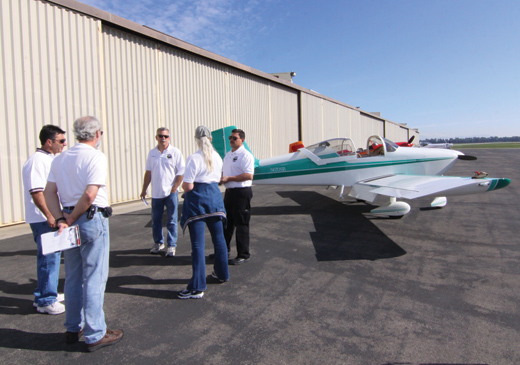
Each mission begins with a thorough briefing. Every formation to be attempted and contingencies for mechanical problems are discussed before anyone mounts up.
As the number of RVs and other Experimental airplanes increases, a great deal of camaraderie with other RV owners develops. Flying together for an outing or the $100 hamburger is a great deal of fun; however, whenever you fly in proximity to another airplane there can be risk. We know it, and we work to mitigate risk wherever possible.
Participation in a formation clinic, where you can meet experienced formation pilots and fly with them is a great and fun way to learn the formation standards and procedures, and to meet new friends with a similar interest. Check www.eaa105.org/Useful_Info/Useful_
Info.html for the various formation groups around the country.
The standard for safe formation flying for civilian airplanes was set in 1999 by Stu McCurdy, a retired Air Force Colonel, with Flight Formation, Inc. (FFI). This organization provides standards and procedures for civilian non-warbird formation flying.
The people I fly with are all good friends. We are lucky at Chino Airport, as there are more than 20 RVs based there, with a dozen active and flying about every weekend. We fly with other friends in the area from Cable, Torrance, Redlands, Riverside and Rosamond Airports, and several other airports in Southern California.
Bottom line: Formation flying is a lot of work, and requires skill, concentration, practice and plenty of patience. I think it makes us all better pilots, more in control of the airplane and proficient with precise, in-flight maneuvering. It makes the difference between a driver and a pilot.



